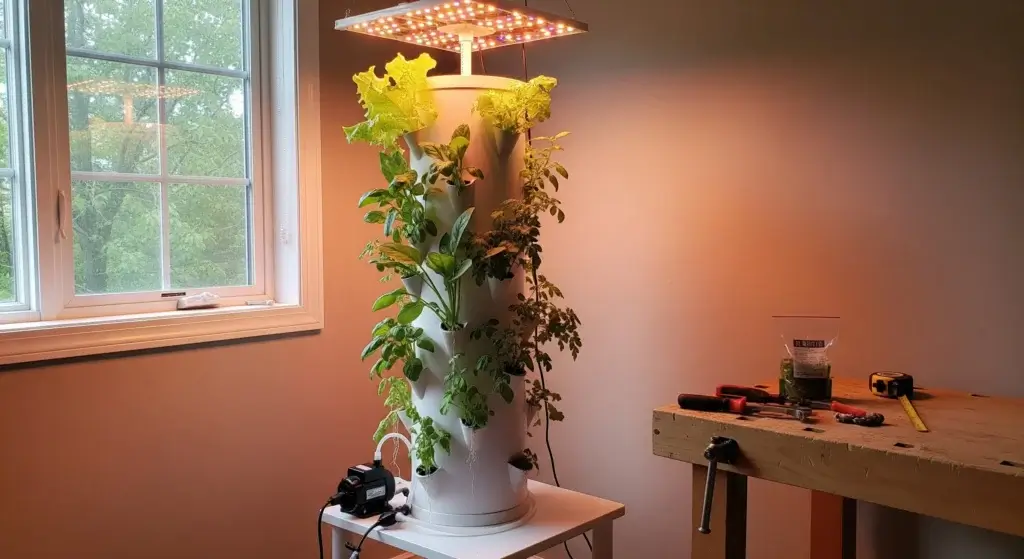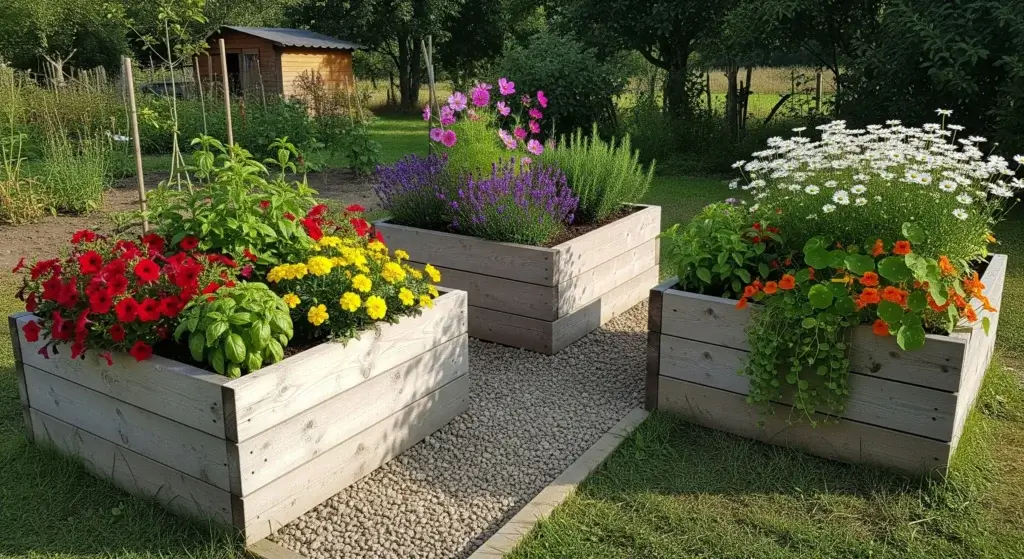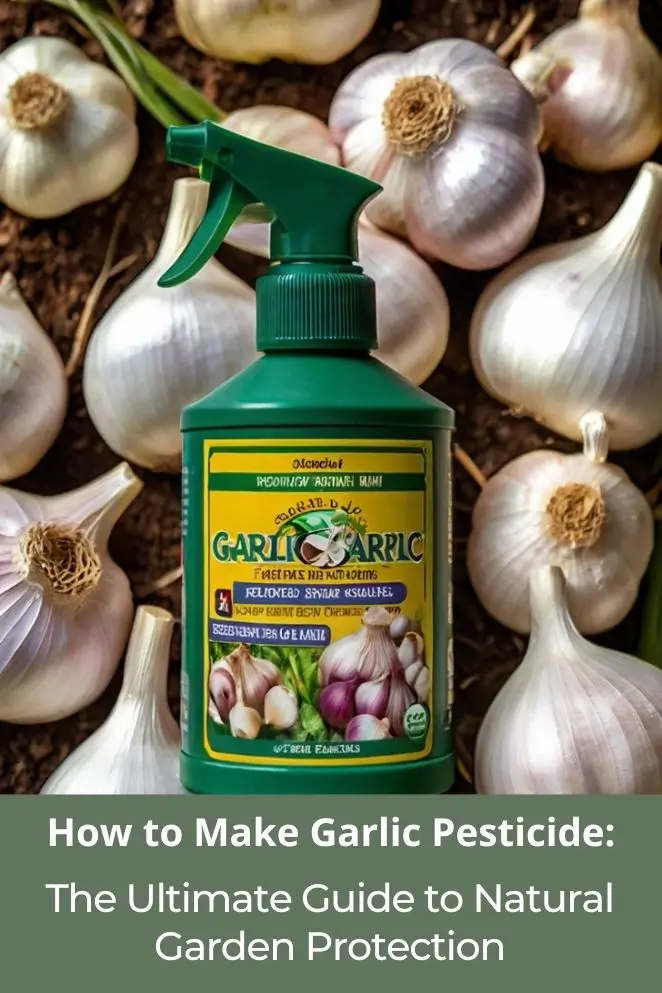
Garlic spray is a go-to natural pest control trick for gardeners who want results without the toxic mess.
It’s cheap, safe, and tough on bugs—no chemicals, no drama.
This guide shows you how garlic keeps pests away, why it works, and how to actually use it like a pro.
Think of it as your garden’s secret vampire repellent—except the vampires are aphids.
Why Garlic Works as a Natural Pesticide
Garlic messes with bugs—and that’s why it works.
It’s packed with sulfur stuff like allicin and diallyl disulfide (fancy names, we know), which stink to us and totally ruin a pest’s day.
That smell throws bugs off their game by hiding the plant scents they normally go after.
When you spray garlic on your plants, it acts like a force field.
Pests can’t eat, mate, or hang around.
Studies even show garlic can work as well as some commercial bug killers.
The best part? It doesn’t just target one kind of bug—it tells most of them to buzz off.
And when used right, it’s chill for humans, pets, bees, and other good guys in your garden.
- Read also: DIY Insecticidal Soap Spray: Protect Your Plants Without Harsh Chemicals
- Read also: Homemade Repellent: DIY Natural Pesticide Spray for Mosquitoes
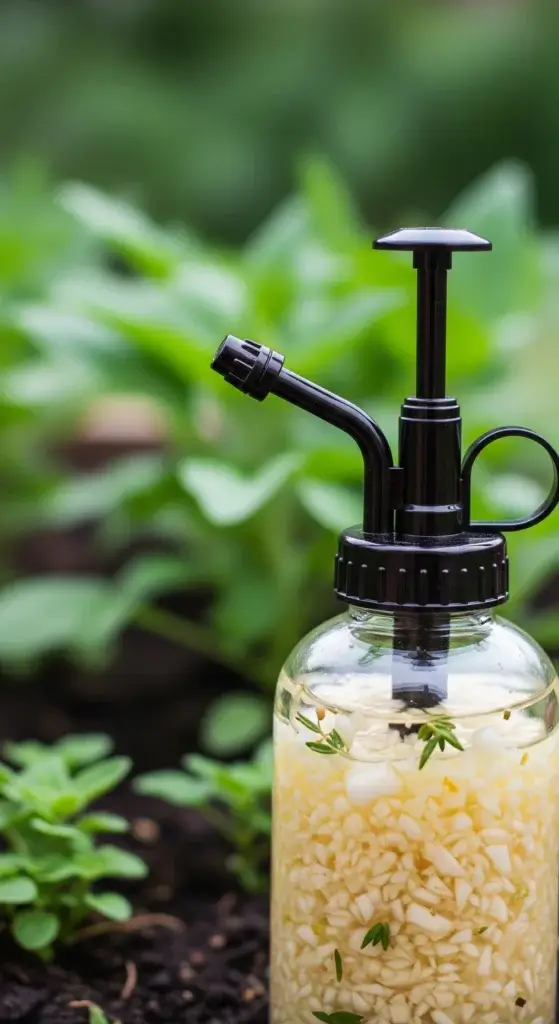
Essential Ingredients and Equipment
To make garlic spray that actually works, you don’t need fancy stuff—just some kitchen basics:
What you need:
- 1 full garlic head (about 10–12 cloves)
- 1 tbsp veggie oil or mineral oil
- 1 tsp biodegradable dish soap
- 4 cups of water (yep, that’s a quart)
Tools:
- Blender or food processor
- Strainer or cheesecloth
- Spray bottle or garden sprayer
- Glass jar for storing leftovers
- Measuring spoons and cups
Pro tip:
Fresh garlic is key. Go for the strong-smelling, firm bulbs.
Garlic powder won’t cut it—it’s too weak.
The oil helps the spray stick to leaves, and the soap makes the water and oil mix like a smoothie for your plants.
Step-by-Step Preparation Instructions
Method 1: Quick garlic spray (ready in 24 ours)
Step 1: Chop the garlic
Break up the garlic bulb into cloves. Don’t peel them—just toss the papery bits.
Chop ‘em roughly so your blender doesn’t hate you.
Step 2: Blend it up
Throw the chopped garlic and 1 tablespoon of oil into a blender or food processor.
Blend it into a paste. Should take about a minute or two.
Step 3: Let it sit
Scoop that garlic paste into a glass jar.
Let it sit out for 24 hours at room temp so the oil pulls out all the good bug-fighting stuff.
Cover the jar loosely—don’t tighten the lid, unless you want a tiny garlic explosion.
Step 4: Strain and add soap
After 24 hours, strain the garlic oil through a mesh strainer or cheesecloth.
Add 1 teaspoon of dish soap and 2 cups of water. Mix it gently—no need for bubbles.
Step 5: Spray time
Now you’ve got a garlic concentrate. To use it, mix 2 tablespoons of it with 2 cups of water in a spray bottle.
Shake and spray. Boom. Bug protection, unlocked.
Method 2: Concentrated garlic extract (stronger, longer-lasting)
For gardeners dealing with persistent pest problems, creating a more concentrated extract provides stronger, longer-lasting protection.
Step 1: Double the garlic, double the power
Use two garlic heads this time.
Chop and blend like before, but add 2 tablespoons of oil to help pull out more of the good stuff.
Step 2: Low heat, no boil
Pour the garlic-oil paste into a double boiler (or a bowl over a pot of hot water).
Warm it gently for 20 minutes—keep it under 140°F.
You’re not cooking soup, just unlocking extra pest-fighting power.
Step 3: Let it chill (for 48 hours)
Take it off the heat and let it sit for two days. Stir it now and then.
The longer it steeps, the stronger it gets. Think of it like marinating, but for bug spray.
Step 4: Strain like a pro
Strain it twice: first with a regular strainer, then with cheesecloth or a coffee filter.
You want it smooth so it doesn’t clog your sprayer.

Target Pests and Effectiveness
Garlic spray isn’t magic—but it’s close.
It hits a lot of common garden pests hard, especially the soft-bodied creepers that like to wreck your plants.
Works really well on:
- Aphids (all the annoying kinds)
- Spider mites
- Whiteflies
- Thrips
- Caterpillars and larvae
- Armyworms
- Cutworms
- Beetles (most types)
- Slugs and snails (if you mix it with extra stuff like chili or vinegar)
Works okay on:
- Scale bugs
- Mealybugs
- Leafhoppers
- Flying pests like flies and mosquitoes (not 100%, but it helps)
Science backs it up, too. One study showed garlic spray (at 85g per 9L of water) worked just as well as some chemical pesticides on cotton aphids.
Same goes for cabbage flies and other farm pests.
Why it works?
Garlic doesn’t just chase bugs away—it blocks how they find plants, messes with how they eat, and can straight-up poison soft-bodied bugs like aphids.
So yeah, it’s basically the garlic bread of pest control: simple, strong, and always a hit.
Application Techniques and Best Practices
If you just splash garlic spray around randomly, bugs will laugh at you.
Here’s how to use it like a pro:
When to spray?
- Early morning or late evening = perfect.
- Hot midday sun (over 85°F) = nope. You’ll burn your plants.
How often?
- Just in case: Spray once a week during the growing season.
- Bugs everywhere: Spray every 3–4 days until they’re gone.
- Rainy week? Bump it up to twice a week—rain washes garlic off.
How to cover plants?
- Spray everything—leaves, stems, even the undersides (that’s where bugs throw secret parties and lay eggs).
- Use a fine mist so you don’t drown your plants.
- Focus on bug-damaged spots first, then spray nearby healthy plants too, just in case pests feel like moving.
Spray like a pro
- Start at the bottom and work your way up. Gravity is your friend.
- Overlap your spray by about 50%. Missed spots = bug hideouts.
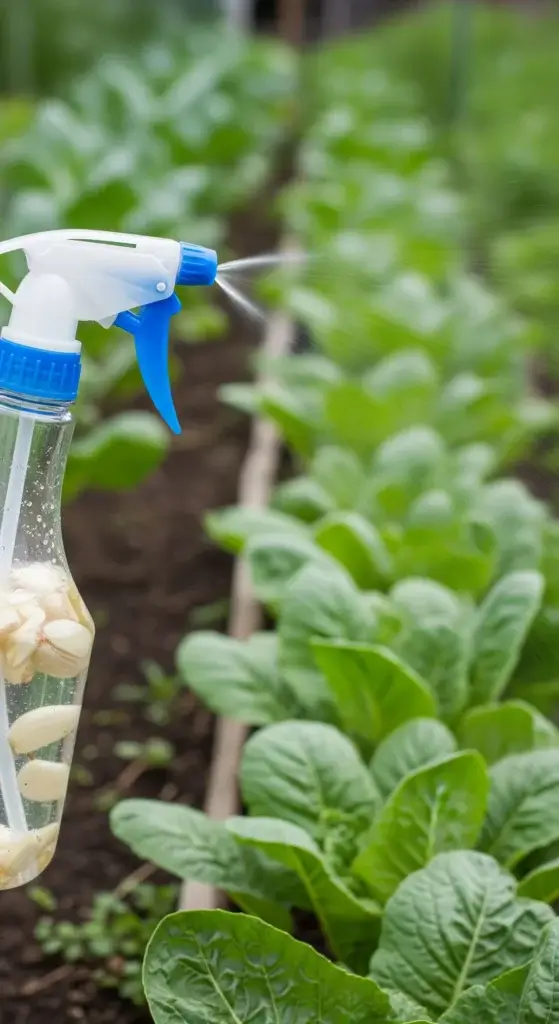
Safety Considerations and Precautions
Garlic spray might be the natural MVP of the garden world, but that doesn’t mean you can just hose down everything like it’s a zombie invasion.
Play it smart, follow these tips, and your plants—and the bugs you actually like—will thank you.
1. Test before you blast
Some plants are drama queens.
Before going full spray mode, test the garlic mix on a small part of the plant—especially the fancy ones with delicate leaves or flowers.
Wait 24–48 hours. If the plant doesn’t throw a fit (a.k.a. no yellowing, spotting, or curling), you’re good to go.
2. Don’t wreck the good guys
Bees, ladybugs, and tiny wasps that eat garden pests are your teammates—not targets.
Garlic spray doesn’t know the difference. So:
- Don’t spray flowers while they’re blooming.
- Spray in the evening, after the pollinators have clocked out.
- Think of it like sending your pest control in after the Avengers have left the building.
3. Pre-harvest rules
Garlic spray can leave your veggies tasting like a pizza topping. If you’re growing food, stop spraying:
- 3–7 days before harvest for most fruits and veggies.
- 7–10 days before picking herbs or leafy greens.
- Nobody wants garlic-flavored mint.
4. Storage: Treat it like a vampire repellent
Store your garlic concentrate in a glass jar. Stick it in a cool, dark place—like a cupboard, not next to the stove. It’ll stay good for about a month. Always label it clearly (no mystery jars!), and keep it away from kids and pets.
Enhancing Effectiveness with Complementary Ingredients
Garlic spray works. But if you want to turn it into a real garden superweapon, mix in a few extras. These add-ons hit harder and help with stuff garlic can’t handle on its own.
1. Add essential oils: Tiny drops, big impact
Essential oils aren’t just for fancy diffusers. A few drops in your garlic mix can give pests the boot fast:
- Peppermint oil (5–10 drops per quart): Wrecks ants and aphids. Smells like a candy cane, fights like Rambo.
- Rosemary oil (3–5 drops per quart): Bugs that fly? This throws them off course.
- Tea tree oil (2–3 drops per quart): Also fights fungi. Your plants basically get spa treatment and security.
2. Spice it up: Hot peppers = extra firepower
Blend 1–2 chopped hot peppers (like cayenne or habanero) with your garlic.
This doesn’t just keep insects away—it tells nosy mammals like rabbits and squirrels to back off.
Think of it as adding pepper spray to your garden’s defense system.
3. Swap the soap
Garlic + oil + water don’t mix well on their own. You need soap to hold it all together.
But you’ve got options:
- Castile soap: Plant-friendly, perfect for organic gardens.
- Horticultural soap: Made for plants. Gets the job done.
- Neem oil: Does double duty—mixes stuff and kills bugs.
Skip the cheap dish soap with fake scents and weird dyes. Your plants deserve better.
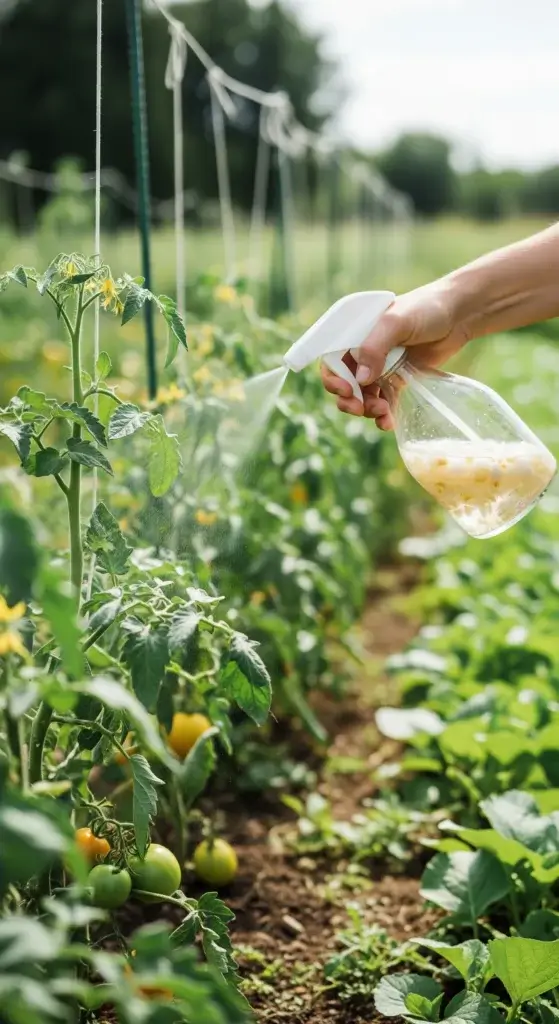
Troubleshooting Common Issues
Even if you’ve been gardening since before TikTok existed, garlic spray can still throw curveballs.
Don’t stress—here’s how to handle the most common issues without tossing your sprayer across the yard.
1. Spray nozzle keeps clogging
This usually means your mix still has bits floating in it.
Fix it:
Strain better. Start with a regular strainer, then use a coffee filter or cheesecloth. I
f it’s still clogging, add a little water and strain again. Basically, no chunks allowed.
2. Your plants look mad (Phytotoxicity)
If leaves curl, burn, or spot after spraying, your garlic mix might be too strong—or the sun made things worse.
Fix it:
Rinse the plant off right away. Next time, cut the mix strength in half and spray in the early morning or late afternoon—not during a heatwave.
3. It stops working
Garlic spray gets weak over time, especially if it’s sitting in sunlight or heat like it’s on vacation.
Fix it:
Store it in a cool, dark place—think cupboard, not windowsill. Make a new batch every month.
If it’s still not doing the job, try making it a little stronger before spraying more often.
4. Pests come back fast
If bugs keep showing up like uninvited party guests, it’s probably a coverage or timing thing.
Fix it:
Make sure you’re spraying all sides of the leaves—top and bottom. During peak pest seasons, it’s okay to spray more often (every few days). Stay consistent.
Environmental Benefits and Sustainability
Using garlic spray instead of chemical pesticides isn’t just smart—it’s the green choice.
Here’s why your garden (and the Earth) wins when you go the garlic route.
1. Breaks down fast
Chemical pesticides can hang around in soil and water for months—or even years—like bad houseguests.
Garlic spray? It breaks down in just a few days. No buildup. No lingering toxins.
Your garden stays clean, and so does the environment.
2. Water-friendly
Worried about spraying near your well, pond, or stream? Don’t be.
Garlic spray doesn’t stick around long enough to mess with water.
It breaks down before it gets that far, so it won’t pollute your local fish hangout or your drinking water.
3. Good for the soil
Unlike synthetic stuff that messes with the good microbes in your dirt, garlic actually helps.
It adds organic compounds that support healthy soil life.
You keep pests away and feed your underground ecosystem. It’s a win-win.
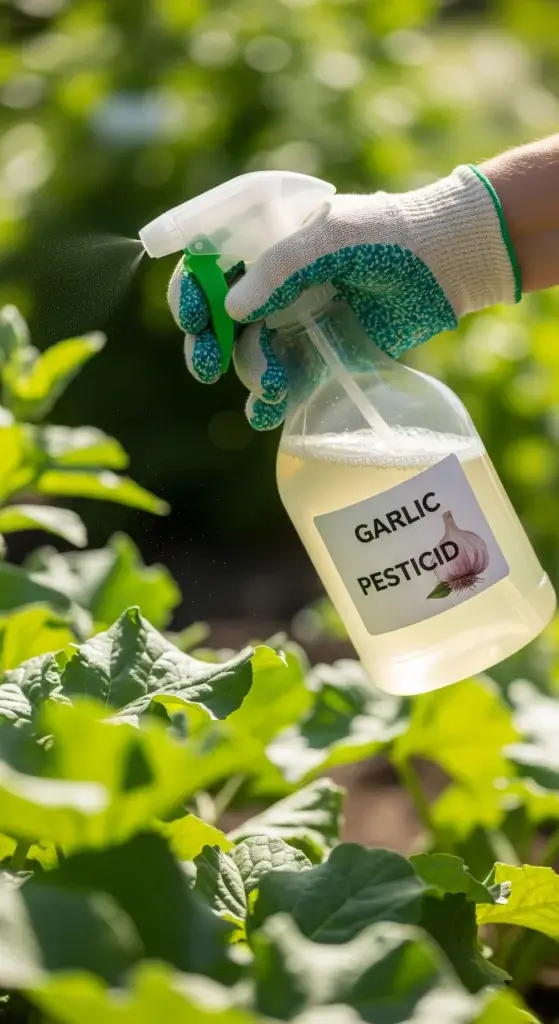
- Read also: DIY Solution: Homemade Plant Insect Spray for a Healthy Garden
- Read also: Homemade Onion Pest Spray: 3 Natural Recipes That Work
Final Take: Garlic Spray Just Works
Garlic spray is cheap, safe, and eco-friendly. It keeps bugs off your plants without trashing your soil, water, or health.
You make it at home, you know what’s in it, and it actually works.
Making your own pest spray gets you closer to your garden—and further from chemical junk.
Whether you’re new to gardening or just tired of harsh products, garlic is a solid go-to.


